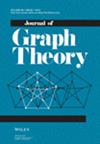求助PDF
{"title":"无 C 2 k + 1 图形的最小度稳定性","authors":"Xiaoli Yuan, Yuejian Peng","doi":"10.1002/jgt.23086","DOIUrl":null,"url":null,"abstract":"<p>We consider the minimum degree stability of graphs forbidding odd cycles: What is the tight bound on the minimum degree to guarantee that the structure of a <span></span><math>\n <semantics>\n <mrow>\n <msub>\n <mi>C</mi>\n \n <mrow>\n <mn>2</mn>\n \n <mi>k</mi>\n \n <mo>+</mo>\n \n <mn>1</mn>\n </mrow>\n </msub>\n </mrow>\n <annotation> ${C}_{2k+1}$</annotation>\n </semantics></math>-free graph inherits from the extremal graph (a balanced complete bipartite graph)? Andrásfai, Erdős, and Sós showed that if a <span></span><math>\n <semantics>\n <mrow>\n <mo>{</mo>\n \n <msub>\n <mi>C</mi>\n \n <mn>3</mn>\n </msub>\n \n <mo>,</mo>\n \n <msub>\n <mi>C</mi>\n \n <mn>5</mn>\n </msub>\n \n <mo>,</mo>\n \n <mtext>…</mtext>\n \n <mo>,</mo>\n \n <msub>\n <mi>C</mi>\n \n <mrow>\n <mn>2</mn>\n \n <mi>k</mi>\n \n <mo>+</mo>\n \n <mn>1</mn>\n </mrow>\n </msub>\n \n <mo>}</mo>\n </mrow>\n <annotation> $\\{{C}_{3},{C}_{5},\\ldots ,{C}_{2k+1}\\}$</annotation>\n </semantics></math>-free graph on <span></span><math>\n <semantics>\n <mrow>\n <mi>n</mi>\n </mrow>\n <annotation> $n$</annotation>\n </semantics></math> vertices has minimum degree greater than <span></span><math>\n <semantics>\n <mrow>\n <mfrac>\n <mn>2</mn>\n \n <mrow>\n <mn>2</mn>\n \n <mi>k</mi>\n \n <mo>+</mo>\n \n <mn>3</mn>\n </mrow>\n </mfrac>\n \n <mi>n</mi>\n </mrow>\n <annotation> $\\frac{2}{2k+3}n$</annotation>\n </semantics></math>, then it is bipartite. Häggkvist showed that for <span></span><math>\n <semantics>\n <mrow>\n <mi>k</mi>\n \n <mo>∈</mo>\n \n <mrow>\n <mo>{</mo>\n \n <mrow>\n <mn>1</mn>\n \n <mo>,</mo>\n \n <mn>2</mn>\n \n <mo>,</mo>\n \n <mn>3</mn>\n \n <mo>,</mo>\n \n <mn>4</mn>\n </mrow>\n \n <mo>}</mo>\n </mrow>\n </mrow>\n <annotation> $k\\in \\{1,2,3,4\\}$</annotation>\n </semantics></math>, if a <span></span><math>\n <semantics>\n <mrow>\n <msub>\n <mi>C</mi>\n \n <mrow>\n <mn>2</mn>\n \n <mi>k</mi>\n \n <mo>+</mo>\n \n <mn>1</mn>\n </mrow>\n </msub>\n </mrow>\n <annotation> ${C}_{2k+1}$</annotation>\n </semantics></math>-free graph on <span></span><math>\n <semantics>\n <mrow>\n <mi>n</mi>\n </mrow>\n <annotation> $n$</annotation>\n </semantics></math> vertices has minimum degree greater than <span></span><math>\n <semantics>\n <mrow>\n <mfrac>\n <mn>2</mn>\n \n <mrow>\n <mn>2</mn>\n \n <mi>k</mi>\n \n <mo>+</mo>\n \n <mn>3</mn>\n </mrow>\n </mfrac>\n \n <mi>n</mi>\n </mrow>\n <annotation> $\\frac{2}{2k+3}n$</annotation>\n </semantics></math>, then it is bipartite. Häggkvist also pointed out that this result cannot be extended to <span></span><math>\n <semantics>\n <mrow>\n <mi>k</mi>\n \n <mo>≥</mo>\n \n <mn>5</mn>\n </mrow>\n <annotation> $k\\ge 5$</annotation>\n </semantics></math>. In this paper, we give a complete answer for any <span></span><math>\n <semantics>\n <mrow>\n <mi>k</mi>\n \n <mo>≥</mo>\n \n <mn>5</mn>\n </mrow>\n <annotation> $k\\ge 5$</annotation>\n </semantics></math>. We show that if <span></span><math>\n <semantics>\n <mrow>\n <mi>k</mi>\n \n <mo>≥</mo>\n \n <mn>5</mn>\n </mrow>\n <annotation> $k\\ge 5$</annotation>\n </semantics></math> and <span></span><math>\n <semantics>\n <mrow>\n <mi>G</mi>\n </mrow>\n <annotation> $G$</annotation>\n </semantics></math> is an <span></span><math>\n <semantics>\n <mrow>\n <mi>n</mi>\n </mrow>\n <annotation> $n$</annotation>\n </semantics></math>-vertex <span></span><math>\n <semantics>\n <mrow>\n <msub>\n <mi>C</mi>\n \n <mrow>\n <mn>2</mn>\n \n <mi>k</mi>\n \n <mo>+</mo>\n \n <mn>1</mn>\n </mrow>\n </msub>\n </mrow>\n <annotation> ${C}_{2k+1}$</annotation>\n </semantics></math>-free graph with <span></span><math>\n <semantics>\n <mrow>\n <mi>δ</mi>\n \n <mrow>\n <mo>(</mo>\n \n <mi>G</mi>\n \n <mo>)</mo>\n </mrow>\n \n <mo>≥</mo>\n \n <mfrac>\n <mi>n</mi>\n \n <mn>6</mn>\n </mfrac>\n \n <mo>+</mo>\n \n <mn>1</mn>\n </mrow>\n <annotation> $\\delta (G)\\ge \\frac{n}{6}+1$</annotation>\n </semantics></math>, then <span></span><math>\n <semantics>\n <mrow>\n <mi>G</mi>\n </mrow>\n <annotation> $G$</annotation>\n </semantics></math> is bipartite, and the bound <span></span><math>\n <semantics>\n <mrow>\n <mfrac>\n <mi>n</mi>\n \n <mn>6</mn>\n </mfrac>\n \n <mo>+</mo>\n \n <mn>1</mn>\n </mrow>\n <annotation> $\\frac{n}{6}+1$</annotation>\n </semantics></math> is tight.</p>","PeriodicalId":16014,"journal":{"name":"Journal of Graph Theory","volume":"106 2","pages":"307-321"},"PeriodicalIF":0.9000,"publicationDate":"2024-02-11","publicationTypes":"Journal Article","fieldsOfStudy":null,"isOpenAccess":false,"openAccessPdf":"","citationCount":"0","resultStr":"{\"title\":\"Minimum degree stability of \\n \\n \\n \\n C\\n \\n 2\\n k\\n +\\n 1\\n \\n \\n \\n ${C}_{2k+1}$\\n -free graphs\",\"authors\":\"Xiaoli Yuan, Yuejian Peng\",\"doi\":\"10.1002/jgt.23086\",\"DOIUrl\":null,\"url\":null,\"abstract\":\"<p>We consider the minimum degree stability of graphs forbidding odd cycles: What is the tight bound on the minimum degree to guarantee that the structure of a <span></span><math>\\n <semantics>\\n <mrow>\\n <msub>\\n <mi>C</mi>\\n \\n <mrow>\\n <mn>2</mn>\\n \\n <mi>k</mi>\\n \\n <mo>+</mo>\\n \\n <mn>1</mn>\\n </mrow>\\n </msub>\\n </mrow>\\n <annotation> ${C}_{2k+1}$</annotation>\\n </semantics></math>-free graph inherits from the extremal graph (a balanced complete bipartite graph)? Andrásfai, Erdős, and Sós showed that if a <span></span><math>\\n <semantics>\\n <mrow>\\n <mo>{</mo>\\n \\n <msub>\\n <mi>C</mi>\\n \\n <mn>3</mn>\\n </msub>\\n \\n <mo>,</mo>\\n \\n <msub>\\n <mi>C</mi>\\n \\n <mn>5</mn>\\n </msub>\\n \\n <mo>,</mo>\\n \\n <mtext>…</mtext>\\n \\n <mo>,</mo>\\n \\n <msub>\\n <mi>C</mi>\\n \\n <mrow>\\n <mn>2</mn>\\n \\n <mi>k</mi>\\n \\n <mo>+</mo>\\n \\n <mn>1</mn>\\n </mrow>\\n </msub>\\n \\n <mo>}</mo>\\n </mrow>\\n <annotation> $\\\\{{C}_{3},{C}_{5},\\\\ldots ,{C}_{2k+1}\\\\}$</annotation>\\n </semantics></math>-free graph on <span></span><math>\\n <semantics>\\n <mrow>\\n <mi>n</mi>\\n </mrow>\\n <annotation> $n$</annotation>\\n </semantics></math> vertices has minimum degree greater than <span></span><math>\\n <semantics>\\n <mrow>\\n <mfrac>\\n <mn>2</mn>\\n \\n <mrow>\\n <mn>2</mn>\\n \\n <mi>k</mi>\\n \\n <mo>+</mo>\\n \\n <mn>3</mn>\\n </mrow>\\n </mfrac>\\n \\n <mi>n</mi>\\n </mrow>\\n <annotation> $\\\\frac{2}{2k+3}n$</annotation>\\n </semantics></math>, then it is bipartite. Häggkvist showed that for <span></span><math>\\n <semantics>\\n <mrow>\\n <mi>k</mi>\\n \\n <mo>∈</mo>\\n \\n <mrow>\\n <mo>{</mo>\\n \\n <mrow>\\n <mn>1</mn>\\n \\n <mo>,</mo>\\n \\n <mn>2</mn>\\n \\n <mo>,</mo>\\n \\n <mn>3</mn>\\n \\n <mo>,</mo>\\n \\n <mn>4</mn>\\n </mrow>\\n \\n <mo>}</mo>\\n </mrow>\\n </mrow>\\n <annotation> $k\\\\in \\\\{1,2,3,4\\\\}$</annotation>\\n </semantics></math>, if a <span></span><math>\\n <semantics>\\n <mrow>\\n <msub>\\n <mi>C</mi>\\n \\n <mrow>\\n <mn>2</mn>\\n \\n <mi>k</mi>\\n \\n <mo>+</mo>\\n \\n <mn>1</mn>\\n </mrow>\\n </msub>\\n </mrow>\\n <annotation> ${C}_{2k+1}$</annotation>\\n </semantics></math>-free graph on <span></span><math>\\n <semantics>\\n <mrow>\\n <mi>n</mi>\\n </mrow>\\n <annotation> $n$</annotation>\\n </semantics></math> vertices has minimum degree greater than <span></span><math>\\n <semantics>\\n <mrow>\\n <mfrac>\\n <mn>2</mn>\\n \\n <mrow>\\n <mn>2</mn>\\n \\n <mi>k</mi>\\n \\n <mo>+</mo>\\n \\n <mn>3</mn>\\n </mrow>\\n </mfrac>\\n \\n <mi>n</mi>\\n </mrow>\\n <annotation> $\\\\frac{2}{2k+3}n$</annotation>\\n </semantics></math>, then it is bipartite. Häggkvist also pointed out that this result cannot be extended to <span></span><math>\\n <semantics>\\n <mrow>\\n <mi>k</mi>\\n \\n <mo>≥</mo>\\n \\n <mn>5</mn>\\n </mrow>\\n <annotation> $k\\\\ge 5$</annotation>\\n </semantics></math>. In this paper, we give a complete answer for any <span></span><math>\\n <semantics>\\n <mrow>\\n <mi>k</mi>\\n \\n <mo>≥</mo>\\n \\n <mn>5</mn>\\n </mrow>\\n <annotation> $k\\\\ge 5$</annotation>\\n </semantics></math>. We show that if <span></span><math>\\n <semantics>\\n <mrow>\\n <mi>k</mi>\\n \\n <mo>≥</mo>\\n \\n <mn>5</mn>\\n </mrow>\\n <annotation> $k\\\\ge 5$</annotation>\\n </semantics></math> and <span></span><math>\\n <semantics>\\n <mrow>\\n <mi>G</mi>\\n </mrow>\\n <annotation> $G$</annotation>\\n </semantics></math> is an <span></span><math>\\n <semantics>\\n <mrow>\\n <mi>n</mi>\\n </mrow>\\n <annotation> $n$</annotation>\\n </semantics></math>-vertex <span></span><math>\\n <semantics>\\n <mrow>\\n <msub>\\n <mi>C</mi>\\n \\n <mrow>\\n <mn>2</mn>\\n \\n <mi>k</mi>\\n \\n <mo>+</mo>\\n \\n <mn>1</mn>\\n </mrow>\\n </msub>\\n </mrow>\\n <annotation> ${C}_{2k+1}$</annotation>\\n </semantics></math>-free graph with <span></span><math>\\n <semantics>\\n <mrow>\\n <mi>δ</mi>\\n \\n <mrow>\\n <mo>(</mo>\\n \\n <mi>G</mi>\\n \\n <mo>)</mo>\\n </mrow>\\n \\n <mo>≥</mo>\\n \\n <mfrac>\\n <mi>n</mi>\\n \\n <mn>6</mn>\\n </mfrac>\\n \\n <mo>+</mo>\\n \\n <mn>1</mn>\\n </mrow>\\n <annotation> $\\\\delta (G)\\\\ge \\\\frac{n}{6}+1$</annotation>\\n </semantics></math>, then <span></span><math>\\n <semantics>\\n <mrow>\\n <mi>G</mi>\\n </mrow>\\n <annotation> $G$</annotation>\\n </semantics></math> is bipartite, and the bound <span></span><math>\\n <semantics>\\n <mrow>\\n <mfrac>\\n <mi>n</mi>\\n \\n <mn>6</mn>\\n </mfrac>\\n \\n <mo>+</mo>\\n \\n <mn>1</mn>\\n </mrow>\\n <annotation> $\\\\frac{n}{6}+1$</annotation>\\n </semantics></math> is tight.</p>\",\"PeriodicalId\":16014,\"journal\":{\"name\":\"Journal of Graph Theory\",\"volume\":\"106 2\",\"pages\":\"307-321\"},\"PeriodicalIF\":0.9000,\"publicationDate\":\"2024-02-11\",\"publicationTypes\":\"Journal Article\",\"fieldsOfStudy\":null,\"isOpenAccess\":false,\"openAccessPdf\":\"\",\"citationCount\":\"0\",\"resultStr\":null,\"platform\":\"Semanticscholar\",\"paperid\":null,\"PeriodicalName\":\"Journal of Graph Theory\",\"FirstCategoryId\":\"100\",\"ListUrlMain\":\"https://onlinelibrary.wiley.com/doi/10.1002/jgt.23086\",\"RegionNum\":3,\"RegionCategory\":\"数学\",\"ArticlePicture\":[],\"TitleCN\":null,\"AbstractTextCN\":null,\"PMCID\":null,\"EPubDate\":\"\",\"PubModel\":\"\",\"JCR\":\"Q2\",\"JCRName\":\"MATHEMATICS\",\"Score\":null,\"Total\":0}","platform":"Semanticscholar","paperid":null,"PeriodicalName":"Journal of Graph Theory","FirstCategoryId":"100","ListUrlMain":"https://onlinelibrary.wiley.com/doi/10.1002/jgt.23086","RegionNum":3,"RegionCategory":"数学","ArticlePicture":[],"TitleCN":null,"AbstractTextCN":null,"PMCID":null,"EPubDate":"","PubModel":"","JCR":"Q2","JCRName":"MATHEMATICS","Score":null,"Total":0}
引用次数: 0
引用
批量引用
摘要
我们考虑的是禁止奇数循环的图的最小度稳定性:要保证不含 C2k+1${C}_{2k+1}$ 的图的结构继承于极值图(平衡的完整二叉图),最小度数的严格约束是什么?Andrásfai、Erdős 和 Sós 发现,如果 n$n$ 个顶点上的{C3,C5,...,C2k+1}${{C}_{3},{C}_{5},\ldots ,{C}_{2k+1}\}$ 无顶图的最小度大于 22k+3n$/frac{2}{2k+3}n$,那么它是双向图。Häggkvist 证明了对于 k∈{1,2,3,4}$k\in \{1,2,3,4/}$,如果 n$n$ 个顶点上的无 C2k+1${C}_{2k+1}$ 图的最小度大于 22k+3n$/frac{2}{2k+3}n$,那么它是双方形的。海格奎斯特还指出,这一结果无法扩展到 k≥5$k\ge 5$。在本文中,我们给出了任意 k≥5$k\ge 5$ 的完整答案。我们证明,如果 k≥5$k\ge 5$ 并且 G$G$ 是一个 n$n$-vertex C2k+1${C}_{2k+1}$-free graph,δ(G)≥n6+1$\delta (G)\ge \frac{n}{6}+1$,那么 G$G$ 是双分部图,并且约束 n6+1$\frac{n}{6}+1$ 是紧密的。
本文章由计算机程序翻译,如有差异,请以英文原文为准。

 求助内容:
求助内容: 应助结果提醒方式:
应助结果提醒方式:


